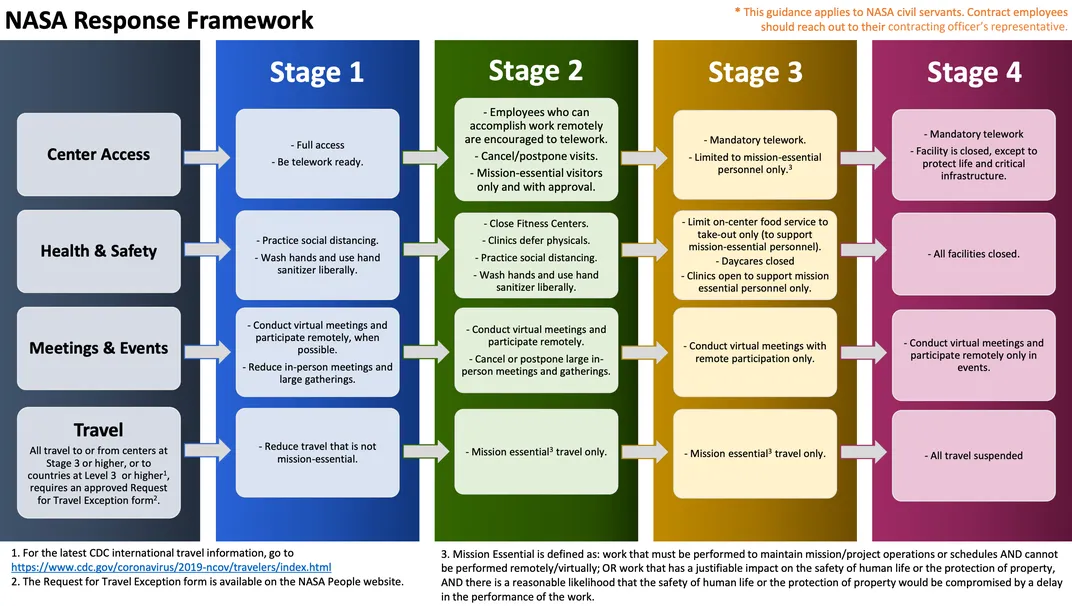NASA Projects Slowed by COVID-19, but New Mars Rover Perseveres
If Perseverance doesn’t launch this year, it will have to wait until 2022
/https://tf-cmsv2-smithsonianmag-media.s3.amazonaws.com/filer/d5/30/d5301c07-df38-443c-bcb5-f4b92c3f7a32/2020_march20_sls.jpg)
Several NASA missions have now been impacted by the COVID-19 pandemic, but as of Friday March 20th, the 2020 Mars rover Perseverance remains on track for takeoff this July.
Last Thursday, NASA announced the closing of the Michoud Assembly Facility in New Orleans, and the Stennis Space Center in southern Mississippi. The closures reflect NASA’s highest level of emergency response, which makes the buildings accessible only to maintain security and critical infrastructure. Employees are required to work from home, so projects that can only be done in the facilities—like building rockets—has to wait.
“Technology allows us to do a lot of what we need to do remotely,” NASA Administrator Jim Bridenstine said in a statement on Friday. “But, where hands-on work is required, it is difficult or impossible to comply with CDC guidelines while processing spaceflight hardware, and where we can’t safely do that we’re going to have to suspend work and focus on the mission critical activities.”
The Michoud Assembly Facility is the construction site of the Space Launch System (SLS) rocket, a modern, more powerful successor to the Saturn V, and Stennis Space Center is the rocket’s testing site. Just like the Saturn V ferried the Apollo 11 astronauts to the moon in the Columbia module in 1969, the SLS will be the vehicle for NASA’s Artemis program, carrying astronauts in the Orion capsule.
NASA has planned to return astronauts to the moon by 2024, but amid the COVID-19 pandemic, the shutdowns have required facilities to “temporarily suspend production and testing of Space Launch System and Orion hardware,” Bridenstine said in a statement on Thursday.
There was one confirmed case of the virus at Stennis Space Center, and even though there were no cases confirmed at the Michoud facility, Bridenstine cites a rise in COVID-19 cases in the surrounding area for its shutdown. Development of the SLS had already been delayed for years and a full test launch wasn’t expected until 2021, per the New York Times’ Kenneth Chang.

The James Webb Space Telescope, the Hubble satellite's successor, will also be impacted by the shutdowns, NASA’s science mission directorate associate administrator Thomas H. Zurbuchen confirmed during a virtual town hall last Friday, per the New York Times. The James Webb Space Telescope, known for its stunning unfolding mirror, is scheduled to launch in March 2021 after years of delays.
“Many people have asked us about James Webb, and of course, it will be impacted, even though it is one of our top priorities,” Zurbuchen said. “It is anticipated by early April, the Webb project could be experiencing a day-for-day schedule impact to its critical path as an increased number of activities come to a halt.”
Other missions remain on schedule. In early April, astronaut Chris Cassidy will join two cosmonauts on a launch to the International Space Station, albeit with less fanfare than usual. Normally, dozens of guests from family to co-workers watch from a crowded room, behind glass, as astronauts put on their spacesuits. Cassidy will say good-bye to his wife three weeks earlier than expected and will have no guests at his April 9 launch to the ISS from a facility in Kazakhstan.
The space agencies already followed a two-week quarantine protocol for anyone travelling to the ISS. In the past, similar measures have prevented astronauts from travelling to space. For example, astronaut Ken Mattingly could not join the Apollo 13 mission after being exposed to rubella and was removed from the crew three days before the launch April 1970.
NASA officials have also given assurances that the Mars 2020 rover Perseverance is on track for a launch in July. According to a statement by the NASA Jet Propulsion Laboratory on Thursday, the six-wheeled rover has just gotten its sample handling systems installed at Kennedy Space Center in Cape Canaveral, Florida. The Kennedy Space Center is currently one level of emergency response below a total shutdown, which means non-essential staff are teleworking, meetings are conducted virtually, and only mission-essential personel.
“We’re going to ensure that we meet that launch window in July,” NASA’s planetary science division director Lori Glaze said during the said during a Thursday virtual town hall, while prioritizing the health and safety of personnel, Per Jeff Faust at SpaceNews. Glaze continued, “As of right now, and even if we go to a next stage of alert, Mars 2020 is moving forward on schedule and everything is, so far, very well on track.”
On March 23, however, it was announced that one Kennedy Space Center employee tested positive for COVID-19, reports Emre Kelly for Florida Today. Officials say that the employee has been teleworking for more than ten days, and they do not believe the individual was contagious when they were last present at the facility.
"This employee was last at the center more than 10 days ago," says Tracy Young, a Kennedy Space Center spokesperson. "Based on the circumstances and elapsed time since the employee was on site, we believe it was acquired after they had started teleworking and there is no additional risk at the center from this person."
Perseverance’s most recently integrated components are a set of drill bits that the rover will use to sample Mars dust, the sample collection arm and a space to store the samples. If Perseverance’s launch were delayed, it would have to wait until 2022 for Earth’s and Mars’ orbits to line up again. But, whether now or in 2022, Perseverance’s launch will go on.
In the virtual town hall on March 20th, Zurbuchen said, “Teams are doing, frankly, heroes’ work to keep us on track for a July launch.”